

Bantu Education Policy. The word ‘Bantu’ in the term Bantu education is highly charged politically and has derogatory connotations.
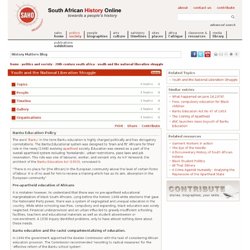
The Bantu Educational system was designed to ‘train and fit’ Africans for their role in the newly (1948) evolving apartheid society. Education was viewed as a part of the overall apartheid system including ‘homelands’, urban restrictions, pass laws and job reservation. This role was one of labourer, worker, and servant only. As H.F Verwoerd, the architect of the Bantu Education Act (1953) , conceived it: “There is no place for [the African] in the European community above the level of certain forms of labour.
Pre-apartheid education of Africans It is mistaken however, to understand that there was no pre-apartheid educational marginalization of black South Africans. Bantu education and the racist compartmentalizing of education. In 1949 the government appointed the Eiselen Commission with the task of considering African education provision. Nkosi Sikelel' iAfrika - Cry Freedom [1987] Films INVICTUS - Films INVICTUS.pdf. Invictus: better on Nelson Mandela than rugby. Invictus (2009)Director: Clint EastwoodEntertainment grade: C–History grade: B+ The South African national rugby union team has been known as the Springboks since the early 20th century.
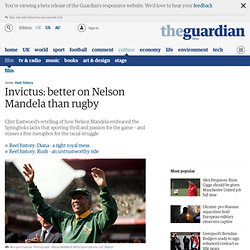
The 1995 World Cup was the first in which South Africa was readmitted to international competition after an apartheid-era boycott. Politics Invictus begins with the release from prison and election to the presidency of Nelson Mandela (Morgan Freeman), who appears in some meticulously recreated documentary-style footage. The film is right to suggest that rugby was an intensely political game in South Africa. Symbolism In the film, Mandela is a lone voice arguing for the ANC to back rugby as a way of offering an olive branch to white Afrikaners. "I don't follow you," Stofile said. Nelson Mandela et le sport : la vraie histoire d'"Invictus"
L'image, relayée par le film de Clint Eastwood Invictus, est devenue légendaire : le 24 juin 1995, les Springboks sud-africains viennent de battre la Nouvelle-Zélande et Nelson Mandela, président depuis un an, revêtu du maillot n° 6 du capitaine blanc François Pienaar, remet à ce dernier la coupe du monde que son pays a remportée.
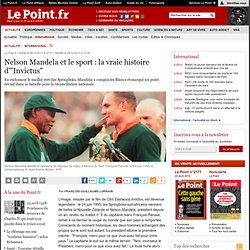
Conscients du moment historique, les deux hommes échangent des propos qui le sont tout autant. Le président allume la première mèche : "François, merci pour ce que vous avez fait pour votre pays. " Le capitaine le suit sur le même terrain : "Non, monsieur le Président, merci pour ce que vous avez fait. " La foule hurle alors : "Nelson, Nelson ! " Une foule composée à 95 % de Blancs. Dans l'imaginaire sud-africain, la scène qui se déroule ce jour-là à l'Ellis Park de Johannesburg renvoie évidemment à un autre stade, celui de Soweto, où Mandela, une semaine après sa libération en 1991, avait été acclamé, mais seulement par le peuple noir.
Invictus: The Day Mandela Flipped the Script. Nelson Mandela once said that sports had the power to change the world...to inspire...to unite people.
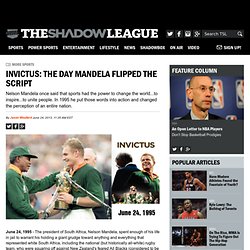
In 1995 he put those words into action and changed the perception of an entire nation. June 24, 1995 - The president of South Africa, Nelson Mandela, spent enough of his life in jail to warrant his holding a giant grudge toward anything and everything that represented white South Africa, including the national (but historically all-white) rugby team, who were squaring off against New Zealand's feared All Blacks (considered to be the greatest rugby organization in the world) in the Rugby World Cup final.
Rather than ignore the event, Mandela showed up for the game in Johannesburg wearing the famous No. 6 jersey of the Springboks captain Francois Pienaar. South African won, 15-12. The honor of the moment "will always be a part of me," said Pienaar afterward. See how it all took place and why the courage of one man has changed the way the world views the power of sports in the video below. Nelson Mandela's Reaction to Invictus. VIDÉO. Nelson Mandela: Les films qui se sont inspirés de sa vie. Morgan Freeman ou encore Idris Elba se sont glissés dans les habits de Nelson Mandela sur grand écran.

Le destin et l’aura de l’ancien président sud-africain, qui a marqué l’histoire grâce à sa lutte contre l’apartheid et pour l’égalité des hommes, ont fait de Nelson Mandela une icône. Bien avant qu’il ne s’éteigne jeudi, plusieurs cinéastes lui ont rendu hommage. Remembering Madiba: Celebs share thoughts on Nelson Mandela. Speeches from Film: Invictus. Just because a speech in a movie is scripted, it doesn’t mean that we cannot learn from it.
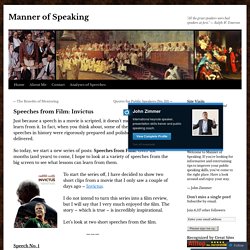
In fact, when you think about, some of the most famous speeches in history were rigorously prepared and polished before they were delivered. So today, we start a new series of posts: Speeches from Film. Over the months (and years) to come, I hope to look at a variety of speeches from the big screen to see what lessons can learn from them. To start the series off, I have decided to show two short clips from a movie that I only saw a couple of days ago – Invictus. I do not intend to turn this series into a film review, but I will say that I very much enjoyed the film. Let’s look at two short speeches from the film. Speech No. 1 The National Sports Council has just voted to change the colours, emblem and name of South Africa’s National Rugby Team, the Springboks. VU HIER. "Invictus": Nelson Mandela selon Clint Eastwood. Invictus (2009. Invictus (poème) Un article de Wikipédia, l'encyclopédie libre.

Pour les articles homonymes, voir Invictus. Le titre latin signifie « invaincu, dont on ne triomphe pas, invincible »[1] et se fonde sur la propre expérience de l'auteur puisque ce poème fut écrit en 1875 sur son lit d'hôpital, à la suite de son amputation du pied. William Henley disait lui-même que ce poème était une démonstration de sa résistance à la douleur consécutive à son amputation. Lorsque le texte est écrit, William Henley a vingt-cinq ans.